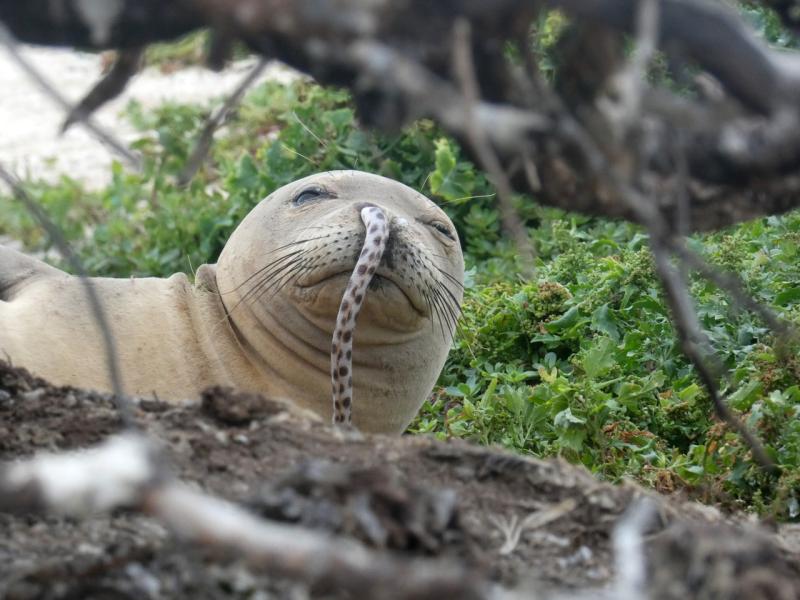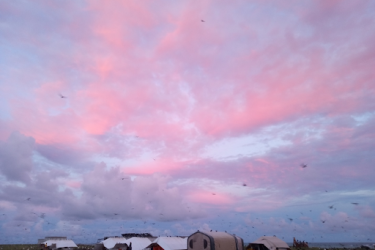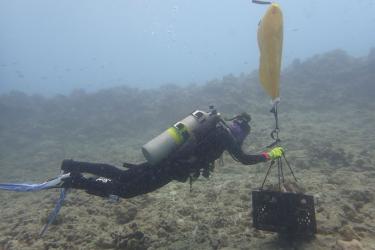Hawaiian monk seals often find themselves in difficult situations, and our staff works hard to prevent and reduce threats to this highly-endangered species. While eel removals are rare, did you know that there are lots of other ways that we protect and save Hawaiian monk seals? All of these individual rescues can add up to saving a species. Research shows that 32 percent of the current Hawaiian monk seal population is alive today because of medical and rescue interventions. Here are some examples:
1. We treat injuries.
![Hawaiian monk seal with wound]()
Interactions with other seals, or other animals such as sharks, can cause bite wounds and abscesses. We treat injuries by draining and cleaning the wounds as well as administering antibiotic drugs. And yes, sometimes we even remove eels from noses! (Photo: NOAA Fisheries)
2. We remove fishing hooks.
![Hooked seal on left and the veterinarian team works to remove a fishing hook on right]()
Fishing gear and hooks are a frequent threat to Hawaiian monk seals. Sometimes, when seals get "hooked," we can remove fishing hooks right away on the beach. Other times, it requires anesthesia or even abdominal surgery. (Photos: NOAA Fisheries)
3. We vaccinate seals.
![Trained staff person vaccinates a monk seal with a pole syringe]()
We use a pole syringe to vaccinate seals against morbillivirus (distemper) in order to prevent an outbreak from devastating the population. (Photo: NOAA Fisheries)
4. We remove marine debris.
![Monk seal entangled in fishing line and buoys on left and staff carefully cuts a fishing line to free a seal on right]()
Seals are curious and will investigate unfamiliar objects such as floating debris and trash. We disentangle seals and other wildlife whenever we find them caught in debris. (Photos: NOAA Fisheries)
5. We free trapped seals.
![Researchers relocate a seal to a safer location]()
Hawaiian monk seals and other wildlife are often trapped behind an aging sea wall at Tern Island, French Frigate Shoals in the Northwestern Hawaiian Islands. Researchers catch trapped seals and carry them to freedom at open beaches. (Photo: NOAA Fisheries)
6. We relocate pups.
![Sharks circle near a monk seal pup and mother]()
Several pupping beaches at French Frigate Shoals are regularly patrolled by Galapagos sharks. We transport pups to safer areas, away from sharks, after they wean from their mothers. (Photo: NOAA Fisheries)
![The team relocates a seal]()
7. We rescue and rehabilitate seals.
![Malnourished pup]()
Together with our partners at The Marine Mammal Center's Ke Kai Ola monk seal hospital, we rescue and rehabilitate seals suffering from malnutrition and disease. (Photo: NOAA Fisheries)
8. We reunite pups and mothers.
![Two pups and their mothers in the ocean along the shore]()
Several times each year, pups get separated from their mothers or mothers switch pups. If a pup is separated from its mother or a switch is potentially life-threatening, we attempt to reunite the pup with its mom. (Photo: NOAA Fisheries)
9. We provide medicine.
![A rescue team provides deworming medication for a young monk seal]()
We give deworming medications to juvenile seals to help them put more of the calories they consume into growth and weight gain. (Photo: NOAA Fisheries)
10. We share the shore.
![Caution sign to protect monk seals]()
We provide outreach and educational opportunities to help the public learn how to coexist with monk seals on public beaches and reduce the impacts of human disturbance. (Photo: NOAA Fisheries)
How can you help?
![A discarded container ensares a monk seal's snout]()
Remove trash and marine debris from the environment to help reduce threats to seals. Reduce your use of single-use plastic and other items. Reuse these items whenever you can. And ultimately, recycle or even refuse plastics. (Photo: NOAA Fisheries)
What can you do?
- Keep beaches clean.
- Reduce, reuse, recycle.
- Keep seals wild—give them space.
- When fishing, pull your fishing line in until the seal leaves the area.
- Keep cats exclusively indoors. Cats that live outdoors spread the Toxoplasma gondii parasite, which is lethal to monk seals and other native wildlife.
- Vaccinate your pets and keep dogs leashed at all times. Dogs have injured and even killed monk seals through attacks and bites, and they can disturb seals resting on the beach. They can also transmit diseases to seals.
- Promote healthy oceans.
- Share your enthusiasm and educate others.
__________
All photos taken under research permit.















